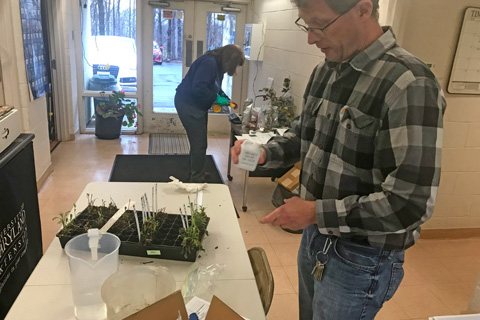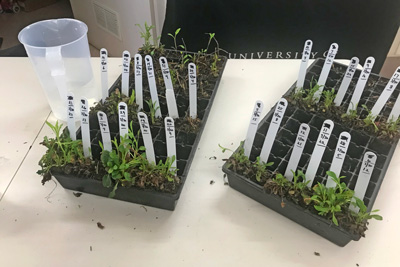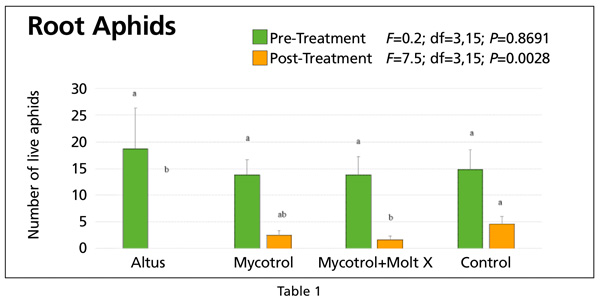12/1/2022
Root Aphids a Growing Problem
Stanton Gill & Brian Kunkel

Rice root aphids (
Rhopalosiphum rufibdominalis) are a growing problem in greenhouses, native and non-native herbaceous plant nurseries, and field hemp and medical marijuana growing operations. In aquatic plant production and herbaceous nurseries producing ornamental plants, the number of plant species being damaged by these pests is increasing both in frequency and number of plants impacted.
Pictured: Brian Kunkel and Suzanne Klick treating plants.
Consequently, the requests for efficacious management options of these two pests, both chemical and biological, has also increased. Several greenhouse operations are producing plugs for field hemp producers and Cannabis sativa for medical marijuana operations. Hemp plants are extremely susceptible to root aphids. In aquatic plant nurseries, we’ve found root aphids feeding on common rush (Juncus affusus) roots, bull rush, ironweed and solidago.
The aphid produces a winged stage called an alate, which can spread the infestation. None of the winged forms are usually found in existing drainage holes in pots and flats, migrating to infest new plants in the greenhouse and nursery.
 For the last four years, we at the University of Maryland Extension and University of Delaware have been collaborating to try to understand these below-ground pests, develop an understanding of their lifecycles and how they move about a nursery operation.
For the last four years, we at the University of Maryland Extension and University of Delaware have been collaborating to try to understand these below-ground pests, develop an understanding of their lifecycles and how they move about a nursery operation.
Pictured: Treatments of insecticides and biopesticides made on ironweed on March 7, 2022.
We’ve also worked with several national biopesticide and pesticide companies in evaluating several materials for effective control. We’ve published a refereed journal article with detailed analysis of each of our trials published in the December 2021 Journal of Environmental Horticulture.
We’ve tested out several systemic and low-risk contact materials for root aphids over the last four years. In 2022, we worked with BioWorks and Bayer, conducting trials to evaluate three of their products. BioWorks supplied Beauveria bassiana and a combination of Beauveria bassiana and Molt-X. Bayer supplied the systemic insecticide flupyradifurone (17.09%, Altus) for our trials.
An aquatic native plant nursery in Maryland supplied solidago plants with a healthy population of root aphids. They also had ironweed plants heavily infested with root aphids. For our trials, we concentrated on the ironweed plants since we had more infested plant available for the trials.
 Treatments were made on March 7, 2022, and each material was applied as a drench. Post-treatment counts were taken on May 27, 2020. The results are presented in Table 1.
Treatments were made on March 7, 2022, and each material was applied as a drench. Post-treatment counts were taken on May 27, 2020. The results are presented in Table 1.
Our field trial was designed to investigate the impact new insecticides and biopesticides have on root mealybugs and rice root aphids. Although our untreated plants saw root aphid populations decline by about 68.5%, some treatments still provided significant control of the pest.
We found that flupyradifurone (Altus) gave 100% control and Beauveria bassiana (Mycotrol) alone didn’t significantly reduce the aphid population, but provided 81.9% control. The combination of Molt-X and Beauveria bassiana did significantly reduce aphid populations and gave about 88% control. GT
Stanton Gill is an Extension Specialist in Entomology and IPM for Greenhouses and Nurseries and the University of Maryland Extension, and professor at Montgomery College, Germantown campus, in the Environmental Horticulture and Sustainable Agriculture Program. He can be reached at Sgill@umd.edu. Brian Kunkel is an Extension Specialist in IPM and Entomology at the University of Delaware Extension. He can be reached at bakunkel@udel.edu.